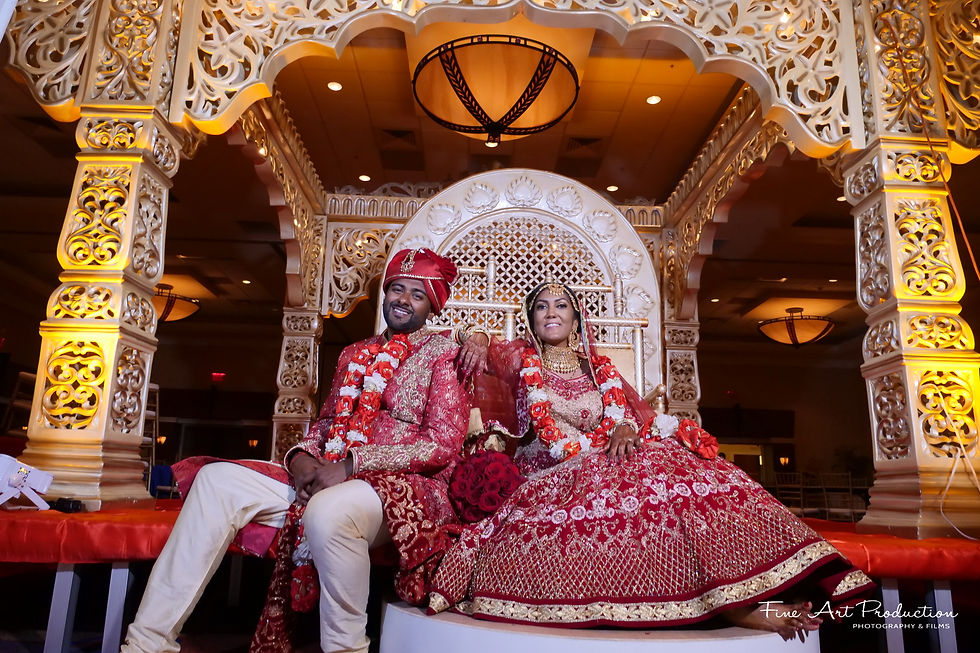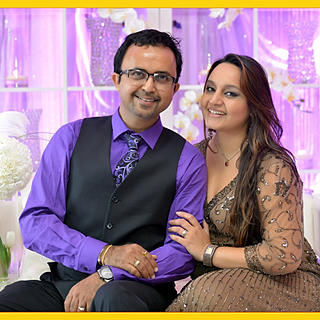Guyanese Wedding Traditions & Guyanese Wedding Photography
- Chirali Amish Thakkar
- Mar 20, 2020
- 6 min read
Guyanese Wedding Traditions & Guyanese wedding photography. Our expert guyanese-wedding-photographer-videographer are available at your service to capture your guyanese-wedding-traditions in a most memorable way. Our guyanese-wedding- videographer will amaze you with our creative style and technology.

There are different religious wedding, Such Hindu Guyanese wedding, Which includes Matikor. That is offering prayer to Mother Earth. Prior to Which the Appropriate time for the ceremony is determined by the priests, based on the numerology of the couple. The rest of the events identify with Any other Hindu Wedding, such as Haldi, Mehndi and Sangeet. Muslim Guyanese Wedding revolves around Nikah. The Christian Guyanese Wedding, on the other hand is based on christia rituals that are observed during, any Christian Wedding around the world.
Guyanese Hindu Wedding:
The Wedding Date is Determined in the Stars; Before the wedding, an auspicious time (known as the muhurta) is fixed for the event. Using the bride and groom’s dates of birth, astrologists calculate the position of planets and stars to reflect the celestial union of the couple. During the ceremony, the gautra of both bride and groom (going back at least three generations) are announced. A gautra is the ancestral lineage or the ancestor’s original clan (this is not related to caste or religion). In Hindu law, marriages should not take place within the same clan.

Matikore:
The matikore or dig dutty as it is popularly called in Guyana is essentially prayers to Mother Earth or Dharti puja and is done two days prior to the wedding. ‘Matti’ means earth and ‘kor’ means digging. The same rites are done separately at the homes of the bride and groom. At the bride’s home, her mother wends her way to a clean spot some distance from their home and to the accompaniment of the tassa drums and traditional songs offer prayers for the fertility and prosperity of her daughter’s marriage. Matikore has traditionally been dominated by the female family members. After applying sindoor, (the mark of married women) to the foreheads of the married women assembled there, female relatives would hoist the tray aloft after collecting a small sample of earth to take to the home for the puja. At her home, the bride traditionally garbed in yellow, symbolizing fertility, sits with the pandit and performs puja. She receives a protective thread or raksha sutra on her wrist and the hardi or dye is blessed. The dye which is said to have restorative, cleansing and beautifying powers is smeared on the bodies of bride and groom after the matikore.
Sangeet Ceremony:
There’s a Pre-Party Called the Sangeet a Few Days before the Wedding Prior to the actual the wedding, there’s a pre-party called the sangeet where family comes together to sing, dance and revel in the joy of the upcoming union. The remainder of the evening is filled with wedding music and dance as the ladies. Tassa has always been the main form of music although many persons have added recorded music to the entertainment. Family members even give performances! The bride’s family sings a traditional folk song to the groom’s family to welcome them.
Mehendi Ceremony:
Elaborate mehndi nights even before the matikor are now trendy. Female friends and relatives of the bride are invited to her home where they reminisce on their childhood, tease her, sing, dance and make merry. Someone skilled in applying the mehendi applies intricate designs on the bride’s hands and feet and even on her friends. With new technology mehendi paste can be bought in tubes or cones, making it easy to apply. Stick-on mehndi tattoos are also fashionable! The artist applying the mehndi to the bride’s hands carefully weaves the groom’s name among the designs telling the blushing bride that the groom has to find all the letters of his name on her wedding day. She is expected to keep the paste on for many hours as it has been said the brighter the colour on the hands the more the bride will be loved by her husband. The Bride’s Hands and Feet Are Adorned with Henna Paint During a Mehndi Ceremony During the mehndi ceremony, which also takes place in Muslim weddings, henna is used to apply intricate designs to the bride’s hands and feet. The mehndi ceremony usually takes place one day before the marriage will be held, as the application can take hours. Wedding Ceremony:
The Couple Weds Under a Mandap The wedding mandap is a temporary structure constructed for the purpose of the marriage ceremony. It may appear on an elevated platform, and is decorated with anything from flowers and greenery to fabric and crystals. The Bride and Groom’s Garments are Tied Together as They Circle a Fire.
The saptapadi is an important ritual in North Indian Hindu weddings. During the saptapadi, the bride and groom have their garments tied together. In South India, the couple walks seven steps together to signify their friendship. In North Indian tradition, they make seven circles around a ceremonial fire, each round signifying a specific blessing they request of the gods. The main significance of saptapadi is establishing friendship, which is the basis of a Hindu marriage.
Red Powder is applied to the Bride’s Hair, Signifying She is Married
Sindoor, a red-orange powder, is applied to the part of a woman’s hair, symbolizes her new status as a married woman and is applied to her hair during the ceremony.
Cords Are Tied to the Wrists of the Bride and Groom During Raksha Bandhan.
Cords are tied to the wrists of both the bride and the groom. Marriage is considered to be an arduous stage in life, and the cords are meant as protection.
Guyanese Muslim Wedding:
The central event in all American-Muslim Weddings will be the Nikah. This is the actual wedding ceremony, usually officiated by a Muslim cleric, an Imam. Although a Nikah can be done anywhere including the bride’s home or reception hall, it is preferable and usually done these days in a mosque. A Muslim wedding is all about love and commitment and happily ever after. There are, however, some traditions and rituals that set this religion’s wedding ceremony apart.
The Wedding Lasts Three Days The three-day affair is perhaps the most unique aspect of a Muslim wedding. If you thought planning a one-day wedding was difficult, just imagine three days’ worth of festivities! The Bride’s Father Agrees to the Marriage Contract on Her Behalf During the Nikah Ceremony The nikah is the part of the ceremony in which the marriage license is signed. The nikah ceremony is essentially the groom’s formal proposal (with at least two witnesses in attendance), as well as the couple’s acceptance of the marriage contract.
In a more traditional Muslim marriage ceremony, the bride’s father or another representative will agree to the marriage contract on her behalf. Following this, both the groom and bride will repeat “Qabul,” which means “I accept,” three times. When the nikah is finished, they will share a piece of sweet fruit.
There Are Readings from the Quran, but Not Necessarily Vows.
The nikah is often followed by a sermon, which may include readings from the Quran. Muslim wedding ceremonies do not always include vows. Agreement to the marriage contract during the nikah suffices as agreement by the bride and groom to enter into marriage. Following the nikah and sermon, a feast is held by the bride’s family.
Guyanese Christian Wedding:
Family and friends of the bride and groom are seated on opposite sides of the church to symbolize the cutting of the blood covenant. These witnesses—family, friends, and invited guests—are all participants in the wedding covenant. Many have made sacrifices to help prepare the couple for marriage and support them in their holy union.
Father Escorts and Gives Away Bride
By escorting her down the aisle, a father says, “I have done my very best to present you, my daughter, as a pure bride. I approve of this man as your choice for a husband, and now I bring you to him.” When the minister asks, “Who gives this woman?,” the father responds, “Her mother and I.” This giving away of the bride demonstrates the parents’ blessing on the union and the transfer of care and responsibility to the husband.
The white wedding dress has a twofold significance. It is a symbol of the wife’s purity in heart and life, as well as her reverence to God. It’s also a picture of the righteousness of Christ described in Revelation 19:7–8. Christ clothes his bride, the church, in his own righteousness as a garment of “fine linen, bright and clean.”
The cutting of the cake is another picture of the cutting of the covenant. When the bride and groom take pieces of cake and feed it to each other, once again, they are showing they have given their all to the other and will care for each other as one flesh. At a Christian wedding, the cutting and feeding of cake can be done joyfully but should be done lovingly and reverently, in a way that honors the covenant relationship.




Comments